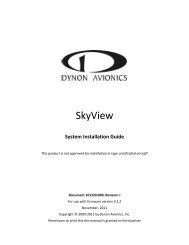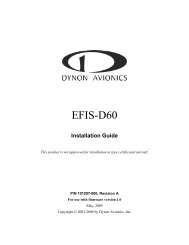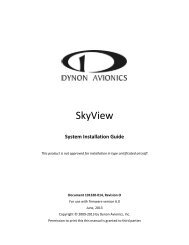EFIS-D100 Installation Guide - Dynon Avionics
EFIS-D100 Installation Guide - Dynon Avionics
EFIS-D100 Installation Guide - Dynon Avionics
Create successful ePaper yourself
Turn your PDF publications into a flip-book with our unique Google optimized e-Paper software.
Autopilot <strong>Installation</strong> and Configuration<br />
STEP 8 – ROLL SERVO FLIGHT TUNING<br />
This set of procedures tunes the settings in the AP > ROLL SERVO menu for the particular<br />
flight characteristics of the aircraft in heading holds and turns.<br />
Note: While this procedure is described assuming you are using HDG mode – where the AP’s<br />
goal is to keep the aircraft’s magnetic heading aligned with the HDG bug – it can be performed<br />
in TRK mode – where the AP’s goal is to keep the aircraft’s ground track aligned with the bug –<br />
instead.<br />
Step 8a – Verify preferred Turn Rate Limit and Bank Angle Limit<br />
On the <strong>EFIS</strong>, perform the following:<br />
SETUP > AP > ROLL SERVO<br />
Verify that the TRN RT LMT and BANK LIMIT parameters are set to values you are<br />
comfortable with.<br />
If you wish to change either of these values prior to or during flight, push DOWN▼ to select<br />
the value, and then DEC - or INC + to modify it.<br />
Step 8b – Ensure that the aircraft is in trim.<br />
Because this test procedure tunes only the Autopilot’s control of roll (so that roll performance<br />
can be isolated), only start the procedure when the aircraft is in neutral trim. During the<br />
following procedures, ensure that your altitude stays constant.<br />
Step 8c – Engage the AP in HDG mode<br />
On the <strong>EFIS</strong>, perform the following:<br />
<strong>EFIS</strong> > AP > HDGOFF.<br />
The <strong>EFIS</strong> synchronizes the HDG bug to the current heading, the Autopilot engages with the<br />
heading bug as its target, and the indicator turns to HDGON.<br />
If you have an AP74 installed and configured, the following performs the same function:<br />
Push HDG button (activates ROLL servo); ensure that the red HDG indicator lights are on.<br />
Ensure that the ALT indicator lights are off; push the ALT button if they are not.<br />
Push the AP button to engage in HDG mode.<br />
The AP status indicator at the lower left of the <strong>EFIS</strong> screen displays: AP:HDG-OFF<br />
Step 8d – Allow a few minutes of stable flight under AP control<br />
Note that the AP is only flying in Heading Hold Mode, so you will need to control the aircraft in<br />
pitch. Ensure that you are not affecting the Autopilot’s control of the roll axis, so you can<br />
determine the AP’s heading hold and change performance.<br />
Step 8e – Adjust roll servo TORQUE and/or SENSITIVITY values as needed<br />
On the <strong>EFIS</strong>, observe the AP status indicator (lower left corner - AP:HDG-OFF) while the AP<br />
flies. If the HDG indicator is frequently highlighted yellow, that is an indication that the Roll<br />
Servo is slipping and the torque needs to be increased. Occasional slips due to turbulence are<br />
acceptable.<br />
If necessary, adjust the TORQUE value in the <strong>EFIS</strong> > SETUP > AP > ROLL SERVO menu.<br />
<strong>EFIS</strong>-<strong>D100</strong> <strong>Installation</strong> <strong>Guide</strong> 6-25
















